Tensiometer
M6500 Spinning Drop Tensiometer
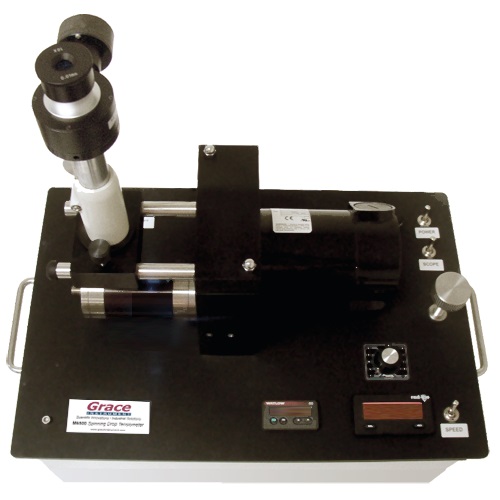 M6500 Spinning Drop Tensiometer (Model displayed may vary with select specifications.)
M6500 Spinning Drop Tensiometer (Model displayed may vary with select specifications.)
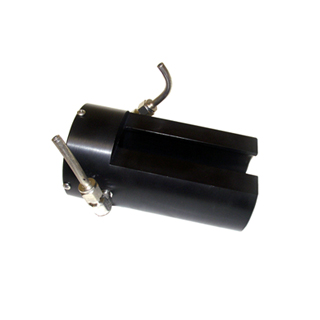 M6500 Chiller Sleeve (Model displayed may vary with select specifications.)
M6500 Chiller Sleeve (Model displayed may vary with select specifications.)
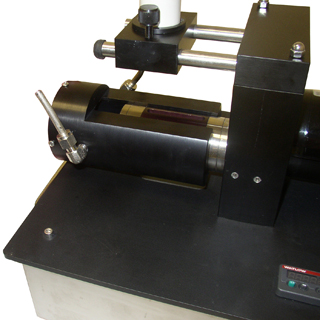 M6500 Chiller Sleeve Attached (Model displayed may vary with select specifications.)
M6500 Chiller Sleeve Attached (Model displayed may vary with select specifications.)
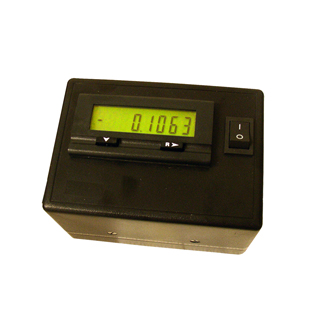 M6500 LCD numerical display (Model displayed may vary with select specifications.)
M6500 LCD numerical display (Model displayed may vary with select specifications.)
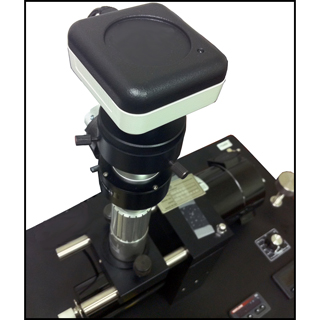 M6500 Digital Camera Imaging System (Model displayed may vary with select specifications.)
M6500 Digital Camera Imaging System (Model displayed may vary with select specifications.)
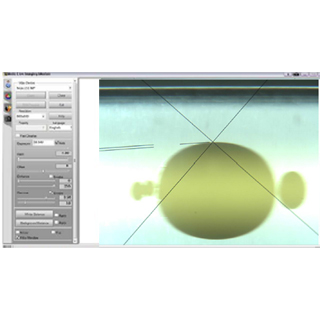 M6500 Image Test Result (Model displayed may vary with select specifications.)
M6500 Image Test Result (Model displayed may vary with select specifications.)






- Dimensions: 19.5" height x 11.5" width x 19" depth
- Weight: 24 lbs.
High-resolution microscope for enhanced accuracy
The M6500 microscope magnifies up to 25x and enables a
numerical display resolution of 0.0001 mm, giving the
researcher the greatest measurement accuracy of any
comparable device
Light-weight and easy to handle
The M6500 weighs only 24 lbs. and includes a level adjustment control and handles on two sides.
This allows the user to pick up and manipulate the unit in order to reposition the test droplet quickly and easily.
The Grace Instrument M6500 Spinning Drop Tensiometer was developed for the measurement of interfacial tension, adsorption rate, and extreme low interfacial tension.
Excellent temperature control and optimum synchronization of the instrument allow the sample to be observed over a long period of time under constant conditions.
When measuring low interfacial tension, the Grace Instrument M6500 Spinning Drop Tensiometer features enhanced accuracy compared to automatic, software-controlled units
thanks to an advanced much-higher-resolution microscope than on competing models.
M6550 HPHT Spinning Drop Tensiometer
Click here to see the HPHT version of the M6500.
| Dimensions: 19.5" height x 11.5" width x 19" depth |
| Weight: 24 lbs. |
| Temperature Range: Ambient (45°F with chiller) to 212 °F |
| Speed Range: 0 to 11,000 rpm continuous |
| Interfacial Tension Measurement 10-6 to 10^2 mN/m |
| Capillary diameter: 2.0 mm |
| Microscope magnification: 25x |
| LCD Numerical Display Resolution: 0.0001 mm |
| Voltage: 120V or 240 V (with transformer) |
| Power: 500 W |
| Frequency: 50-60 Hz |
| Digital Camera Imaging System: (Requires Microsoft Windows XP or later OS for operation) |
| Live Resolution: 2.0 MP |
| Optical Format: 1/3" |
| Focusable Lens: 16 mm |
- Measurement of extremely low interfacial tension
- Accurate RTD temperature readout
- Advanced PID temperature controller
- Accurate speed controller ensures high image synchronization
- High accuracy of reading with stroboscope illumination
- LCD numerical display for integrated microscope
- Light weight
- Adjustable leveling
- Optional chiller sleeve for low temperature applications
- Optional digital camera imaging system (includes third-party PC software for data measurement and image processing)
Downloads for the M6500 Spinning Drop Tensiometer:
Read more about our instrument's technical applications within these scientific and academic publications:
-
Enhanced Oil Recovery Formulations for Liquid-Rich Shale Reservoirs, Volume 368, July 2024, 131573
A Grace M6500 was used to measure the interfacial tension between the oil and liquid phases as well as cover a wider range of IFT values.
https://www.sciencedirect.com/science/article/pii/S001623612400721X
-
Fracture-Fluid Chemistry Optimization to Improve Hydrocarbon Recovery for Shale and Tight Assets, April 2024
The interfacial tension between oil and brine was measured using a Grace M6500 Spinning Drop Tensiometer.
https://onepetro-org.srv-proxy1.library.tamu.edu/SPEIOR/proceedings/24IOR/3-24IOR/D031S020R003/544303?searchresult=1
-
Inorganic Chemistry Communications, Volume 155, September 2023, 111125 2023
Synergy of Surfactant Mixtures and Fe3O4 Nanoparticles for Enhanced Oil Recovery (EOR)
Interfacial tension between oil and surfactant solution was measured with an M6500 Spinning Drop Tensiometer from Grace Instrument Company at 74°C(reservoir temperature) and a rotational speed of 6000 RPM.
https://www.sciencedirect.com/science/article/pii/S1387700323007372
-
Fuel, Volume 350, 15 October 2023, 128-760 2023
Improving the Interfacial Performance and the Adsorption Inhibition of an Extended-Surfactant Mixture for Enhanced Oil Recovery Using Different Hydrophobicity Nanoparticles
Interfacial tension was measured with a Grace M6500 Spinning Drop Tensiometer between different surfactants and oil with nanoparticles introduced.
https://www.sciencedirect.com/science/article/pii/S001623612301373X
-
URTEC-3860394-MS 2023
Nano-Surfactant Packages for Enhanced Oil and Gas Recovery in Hydraulic Fracturing-Impact on the Nano-Sizers on the Performance of Conventional Surfactants
A Grace M6500 Spinning Drop Tensiometer was used to measure the tension between nano-surfactant formulations and Wolfcamp oil blend.
https://onepetro.org/URTECONF/proceedings-abstract/23URTC/3-23URTC/D031S074R007/520612
-
Geoenergy Science and Engineering, Volume 223, April 2023, 211-582 2023
Experimental Investigation of Hydrophobic and Hydrophilic Silica Nanoparticles on Extended Surfactant Properties: Micro-Emulsion, Viscosity and Adsorption Behaviors
Interfacial tension between excess oil and aqueous phases were measured with a M6500 Spinning Drop Tensiometer.
https://www.sciencedirect.com/science/article/pii/S0920410521015151
-
Energy Reports, Volume 8, November 2022, Pages 7800-7813 2022
Surfactant Formulation for Green Enhanced Oil Recovery
A Grace M6500 Spinning Drop Tensiometer was used to measure interfacial tension between crude oil and different surfactants.
https://www.sciencedirect.com/science/article/pii/S2352484722011398
-
SPE-212385-STU 2022
Increase in the Oil Recovery Factor through the Injection of Nano-Chemicals Dispersed in Gas
A Grace M6500 Spinning Drop Tensiometer was used to measure the interfacial tension between oil droplets and aqueous phase of nanofluids at reservoir temperature.
https://onepetro.org/SPEATCE/proceedings-abstract/22ATCE/1-22ATCE/D011S999R005/509348
-
Journal of Petroleum Science and Engineering, Volume 209, February 2022, 109-882 2022
Enhanced Oil Recovery by Emulsion Injection in Heterogeneous Heavy Oil Reservoirs: Experiments, Modeling and Reservoir Simulation
Oil-water interfacial tension was measured with a M6500 Spinning Drop Tensiometer.
https://www.sciencedirect.com/science/article/pii/S0920410521014996
-
Fuel, Volume 292, 15 May 2021, 120-331 2021
Polymer-Free Viscoelastic Fluid for Improved Oil Recovery
Interfacial tension between excess water and excess oil phases of microemulsions were measured with a M6500 Spinning Drop Tensiometer.
https://www.sciencedirect.com/science/article/pii/S0016236121002076
-
Fuel, Volume 289, 1 April 2021, 119-981 2021
Effect of Different Low Salinity Flooding Schemes and the Addition of Alkali on the Performance of Low-Salinity Waterflooding during the Recovery of Heavy Oil from Unconsolidated Sandstone
Interfacial tension between low salinity brine and heavy oil were measured with a M6500 Spinning Drop Tensiometer.
https://www.sciencedirect.com/science/article/pii/S001623612032977X
-
Journal of Petroleum Science and Engineering, Volume 197, February 2021, 108-113 2021
Emulsion-Assisted Thermal Recovery Method In Heterogeneous Oilsands Reservoir
Interfacial tension between oil and alkali-surfactant solutions were measured with a M6500 Spinning Drop Tensiometer.
https://www.sciencedirect.com/science/article/pii/S0920410520311670
-
SPE-204460-PA 2021
Feasibility Study of Dual-Function Chemical in Reducing Surfactant Adsorption and Interfacial Tension for Chemical Enhanced Oil Recovery Application
A Grace M6500 Spinning Drop Tensiometer was used to measure the interfacial tension between crude oil and surfactant solution.
https://onepetro.org/REE/article-abstract/24/01/37/453411/Feasibility-Study-of-Dual-Function-Chemical-in?redirectedFrom=fulltext
-
Colloids and Surfaces A: Phsiochemical and Engineering Aspects, Volume 610, February 2021, 125-694 2021
Pickering Emulsion Stabilized by Organoclay and Intermediately Hydrophobic Nanosilica for High-Temperature Conditions
Rheological data of emulsions were measured at room temperature with a Couette-type Grace M3600 Viscometer.
https://www.sciencedirect.com/science/article/pii/S0927775720312875
-
Journal of Petroleum Science and Engineering, Volume 195, December 2020, 107-885 2020
Real-Time Synchrotron-Based X-Ray Computed Microtomography During in situ Emulsification
Interfacial tension between emulsion phase and brine were measured with a M6500 Spinning Drop Tensiometer.
https://www.sciencedirect.com/science/article/pii/S0920410520309426
-
SPE-2003403-MS 2020
Geomaterial Microfluidics for the Visualization of Alkaline Surfactant Polymer Flooding
Interfacial tension of geomaterial microfluids were measured with a Grace M6500 Spinning Drop Tensiometer.
https://onepetro.org/SPEATCE/proceedings-abstract/20ATCE/2-20ATCE/D022S061R009/451237
-
Fuel, Volume 279, 1 November 2020, 118-456 2020
Effect of Spontaneous Emulsification on Oil Recovery in Tight Oil-Wet Reservoirs
Interfacial tension between imbibition fluids and oil were measured with a M6500 Spinning Drop Tensiometer.
https://www.sciencedirect.com/science/article/pii/S0016236120314526
-
Fuel, Volume 277, 1 October 2020, 118-203 2020
Development of Silicon Quantum Dots Based Nano-Fluid for Enhanced Oil Recovery in Tight Bakken Cores
Interfacial tension and contact angle measurements of oil-water were measured with a M6500 Spinning Drop Tensiometer.
https://www.sciencedirect.com/science/article/pii/S0016236120311996
-
SPE-200383-MS 2020
Use of In-Situ CO2 Generation in Liquid-Rich Shale
Interfacial tension between oil phase and EOR chemical formations were measured with a Grace M6500 Spinning Drop Tensiometer.
https://onepetro.org/SPEIOR/proceedings-abstract/20IOR/1-20IOR/D011S013R001/448445
-
Fuel, Volume 273, 1 August 2020, 117-751 2020
Conformance Control in Heterogeneous Two Dimensional Sandpacks by Injection of Oil-in-Water Emulsion: Theory and Experiments
Oil-water IFT measurements were conducted using a M6500 Spinning Drop Tensiometer taken from oil sands deposits.
https://www.sciencedirect.com/science/article/pii/S0016236120307468
-
Journal of the Taiwan Institute of Chemical Engineers, Volume 106, January 2020, pages 116-182 2020
Experimental and numerical study of surfactant solution spontaneous imbibition in shale oil reservoirs
Core samples were obtained from the Permian Basin and vacuumed for three days before saturated with shale oil for a week. Commercial surfactants were selected based on their performance in IFT reduction and capacity of wettability alteration. The M6500 Spinning Drop Tensiometer was then used to measure IFTs.
https://www.sciencedirect.com/science/article/pii/S0009250919307389
-
Chemical Engineering Science, Volume 211, 16 January 2020, 115-248 2020
A model of emulsion plugging ability in sandpacks: Yield pressure drop and consistency parameter
Oil-in-water and different types of alkalis and emulsifiers were selected to create emulsion systems to calculate sandpack permeability. The IFT between the oil-in-water and emulsifiers were calculated with the M6500 Spinning Drop Tensiometer from Grace Instruments Inc.
https://www.sciencedirect.com/science/article/pii/S0009250919307389
-
Fuel, Volume 259, 1 January 2020, 116-236 2019
Zwitterionic-anionic surfactant mixture for chemical enhanced oil recovery without alkali
IFT was measured were conducted between crude oil from shale formations obtained from North Dakota and zwitterionic and anionic surfactant solutions in the absence of alkali to investigate recovery performance of each surfactant.
https://www.sciencedirect.com/science/article/pii/S001623611931590X
-
Fuel, Volume 257, 1 December 2019, 116-024 2019
Optimization of plugging high mobility zones in oil sands by injection of oil-in-water emulsion: Experimental and modeling study
IFT was measured between oil samples and various chemical additives such as alkalis and surfactants after emulsification of each chemical solution with oil.
https://www.sciencedirect.com/science/article/pii/S001623611931378X
-
Fuel, Volume 254, 15 October 2019, 115-698 2019
Design of extended surfactant-only EOR formulations for an ultrahigh salinity oil field by using hydrophilic lipophilic deviation (HLD) approach: From laboratory screening to simulation
IFT was measured between equilibrated samples of excess oil and excess aqueous phase from various samples of crude oil and brine solution retrieved from a targeted reservoir.
https://www.sciencedirect.com/science/article/pii/S0016236119310506
-
Fuel, Volume 254, 15 October 2019, 115-575 2019
Isolated mechanism study on in situ CO2 EOR
The effects of ICE systems were evaluated experimentally for their effects on IFT and wettability reversal. IFT measurements between an oil phase and aqueous phase were obtained using a M6500 spinning drop tensiometer (Grace Instrument Inc., Houston, TX)
https://www.sciencedirect.com/science/article/pii/S0016236119309184
-
Fuel, Volume 254, 15 October 2019, 115-543 2019
Investigation of oil production and flowback in hydraulically-fractured water-wet formations using the Lab-on-a-Chip method
IFT measurements of two surfactants were obtained using a M6500 spinning drop tensiometer (Grace Instrument Inc., Houston, TX)
https://www.sciencedirect.com/science/article/pii/S0016236119308841
-
SPE-199774-STU 2019
Study of Surfactant-Based Shale Oil EOR Under High Confining Pressure Conditions
A Grace M6500 Spinning Drop Tensiometer was used to measure the interfacial tension between oil and surfactants ranging from ultra-low, low, intermediate to high IFTs.
https://onepetro.org/SPEATCE/proceedings-abstract/19ATCE/2-19ATCE/D023S103R012/217385
-
SPE-195262-MS 2019
Optimization of Immiscible Alkaline-Surfactant-Alternated-Gas/CO 2 Flooding in an Upper Assam Oilfield
A Grace M6500 Spinning Drop Tensiometer was used to measure the interfacial tension between oil and alkaline-surfactant.
https://onepetro.org/SPEWRM/proceedings-abstract/19WRM/4-19WRM/D041S017R003/218751
-
Journal of Petroleum Science and Engineering, Volume 179, August 2019, 192-198 2019
FT-ICR MS determination of the role of naphthenic acids on the stabilization of alkali/surfactant/polymer emulsified effluents: A field study
The IFT between oil and water was determined using a spinning drop tensiometer (Grace Instrument M6500, Houston, TX).
https://www.sciencedirect.com/science/article/abs/pii/S0920410519303845
-
Fuel, Volume 244, May 2019, 335-351 2019
Study of conformance control in oil sands by oil-in-water emulsion injection using heterogeneous parallel-sandpack models
IFT measurements were conducted using a M6500 spinning-drop tensiometer (Grace Instrument Inc., USA).
https://www.sciencedirect.com/science/article/pii/S001623611930225X
-
Fuel, Volume 236, January 2019, 851-860 2019
Flow regimes during surfactant flooding: The influence of phase behaviour
IFT measurements were obtained by a spinning drop tensiometer (M6500 Grace Instrument, United States)
https://www.sciencedirect.com/science/article/pii/S001623611831456X
-
SPE-195116-MS 2019
Enzyme Enhanced Oil Recovery EEOR: A Microfluidics Approach
A spinning drop tensiometer Grace Instrument M6500 was used to measure IFT based on the principle that the IFT and centrifugal forces are balanced at mechanical equilibrium.
https://onepetro.org/conference-paper/SPE-195116-MS
-
Colloids and Surfaces A: Physicochemical and Engineering Aspects, Volume 558, December 2018, 123-129 2018
Mobilization of n-hexadecane in porous media using food grade amphiphiles
Spinning drop tensiometry (Grace Instrument M6500 Spinning Drop Tensiometer) was employed to measure the static interfacial tension between the hexadecane (density = 0.77 g/cm3) and each of the surfactant mixtures (density = 1.0510 ± 0.0018 g/cm3).
https://www.sciencedirect.com/science/article/pii/S0927775718308331
-
SPE-190172-MS 2018
Boosting Oil Recovery in Unconventional Resources Utilizing Wettability Altering Agents: Successful Translation from Laboratory to Field
The surface tension and interfacial tension between the brine and oil phases were measured using Grace Instrument M6500 Spinning Drop Tensiometer and a Kruss K100 with a Wilhelmy Plate.
https://onepetro.org/conference-paper/SPE-190172-MS
-
SPE-189523-MS 2018
Treating Liquid Banking Problem to Increase Shale Gas Wells Productivity
The surface tension and interfacial tension between the brine and oil phases were measured using Grace Instrument M6500 Spinning Drop Tensiometer and a Kruss K100 with a Wilhelmy Plate.
https://onepetro.org/conference-paper/SPE-189523-MS
-
Journal of Colloid and Interface Science, Volume 524, August 2018, 279-288 2018
Microstructural characteristics of surfactant assembly into a gel-like mesophase for application as an oil spill dispersant
Interfacial tensions were measured by the spinning drop and pendant drop techniques to span the range of crude oil-sa ine water interfacia tensions. For ow interfacia tensions (≤ 2 mN/m) of the dispersantoil mixtures, the interfacial tension was measured using the spinning drop technique (Grace Instrument model M6500 tensiometer). The tensiometer uses a rotating capillary of 2 mm inner diameter with total volume of 0.292 cm3.
https://www.sciencedirect.com/science/article/pii/S002197971830345X
-
Fuel, Volume 222, June 2018, 561-568 2018
Using carbonaceous nanoparticles as surfactant carrier in enhanced oil recovery: A laboratory study
After the systems reached equilibrium, the resulted interfacial tension (IFT) between the excess water and excess oil phases of microemulsions was measured at 50 °C with a M6500 Spinning Drop Tensiometer (Grace Instrument, Houston, TX).
https://www.sciencedirect.com/science/article/pii/S0016236118303922
-
Colloids and Surfaces A: Physicochemical and Engineering Aspects, Volume 520, May 2017, 712-721 2017
Using carbonaceous nanoparticles as surfactant carrier in enhanced oil recovery: A laboratory study
The surface tension and interfacial tension between the brine and oil phases were measured using Grace Instrument M6500 Spinning Drop Tensiometer and a Kruss K100 with a Wilhelmy Plate.
https://www.sciencedirect.com/science/article/pii/S0927775717301632
-
SPE-185832-MS 2017
Alkaline Surfactant Polymer Flooding: What Happens at the Pore Scale?
Alkaline-surfactant-polymer (ASP) flooding (Chemical EOR) is one of the most promising worldwide focus of Chemical EOR research and field trials. Polymers increase the viscosity of injected water, which improves the sweep efficiency by counteracting heterogeneity effects. Surfactants decrease IFT between water and oil, improving displacement efficiency by moving trapped oil. An average of 22% incremental oil recovery was reported in this lab when evaluating 21 fields that used ASP flooding. ASP flooding- decrease IFT, increase capillary number. The Grace M6500 was used for the IFT measurements of the surfactant-oil-water system.
https://www.onepetro.org/conference-paper/SPE-185832-MS
-
SPE-184550-MS 2017
Investigation of Oil Adhesion to Shale Rocks for EOR
The surface tension and interfacial tension between the brine and oil phases were measured using a Grace Instrument Spinning Drop Tensiometer Model M6500 and a Kruss K100 with a Wilhelmy Plate.
https://www.onepetro.org/conference-paper/SPE-184550-MS
-
Journal of Hazardous Materials Volume 334, Pages 168–177 2017
Formulation of crude oil spill dispersants based on the HLD concept and using a lipopeptide biosurfactant
The equilibrium IFT was measured between the excess water and oil phases using a glass capillary tube and a spinning drop Tensiometer (M6500, Grace Instrument) similar to Nguyen.
http://www.sciencedirect.com/science/article/pii/S0304389417302479
-
SPE-188046-MS 2017
NanoSurfactant for EOR in Carbonate Reservoirs
A Grace M6500 Spinning Drop Tensiometer was used to measure the interfacial tension between crude oil and STRX nano-surfactant. The M6500 Spinning Drop Tensiometer also measured STRX co-surfactant alone.
https://onepetro.org/SPESATS/proceedings-abstract/17SATS/3-17SATS/D033S028R003/196091
-
Colloids and Surfaces A: Physicochemical and Engineering Aspects, Volume 509, November 2016, 440-448 2016
Both-branch amphiphilic polymer oil displacing system: Molecular weight, surfactant interactions and enhanced oil recovery performance
The oil–water interfacial tension (IFT) between aqueous phase and oil phase was measured at 25 °C using a M6500 Spinning Drop Tensiometer manufactured by Grace Instrument Co., USA.
https://www.sciencedirect.com/science/article/pii/S0927775716307804
-
SPE-179541-MS 2016
Optimizing Water Chemistry to Improve Oil Recovery from the Middle Bakken Formation
Investigation of interfacial tension reduction between Bakken oil and different surfactant formulations at 90°C. Each individual measurement was run for 2-4 hours before reading after the oil drop was stable in the tensiometer.
http://dx.doi.org/10.2118/179541-MS
-
IPTC-18601-MS 2016
Laboratory Evaluation of Chemical EOR Process for Viscous and High EACN Oil in East African Oilfields
Using Grace M6500 spinning drop tensiometer, the IFTs were measured at constant temperature of 80 °C and rotation speed of 4200 rpm. The IFTs were recorded every 5-minute interval for 90minute duration, as are depicted in Figure 8. Both of the measurements for S4 and S5 showed that the IFT could only be reduced to 10-2 dyne/cm, below the required KPI of 10-3 dyne/cm.
https://www.onepetro.org/conference-paper/IPTC-18601-MS
-
ProQuest Dissertations Publishing, 2016. 10155654 2016
Development of High Performance Surfacant Formulations For an ASP Flooding
IFT measurement was run by spinning-drop tensiometer (m6500) manufactured by Grace Instrument Company. This tensiometer has an interfacial tension measurement range from 10-6 to 10-1 mN/m, a microscope magnification up to 25X and temperature range from 45 ºF to 212 ºF.
http://search.proquest.com/openview/cf137e6ba625baad3b37329e16293dd9/1?pqorigsite=gscholar&cbl=18750&diss=y
-
AIP Conference Proceedings Volume 1787, Issue 1 10.1063/1.4968129 2016
Rheological behavior on treated Malaysian crude oil
The IFT was measured using grace spinning drop tensiometer M6500. All the controllers- power switch, strobe light switch, rotation switch and micrometer switch, all turned on.
https://doi.org/10.1063/1.4968129
-
AIP Conference Proceedings 1787, 060002 2016
Chemical Flood Under High Total Dissolved Solids (TDS) Conditions
Grace instrument M6500 spinning drop Tensiometer. Equilibrium IFT was measured between the excess water and excess oil phases of microemulsions. The excess water phase of a microemulsion was added into the spinning drop glass tube.
https://shareok.org/bitstream/handle/11244/10506/2014_Wan_Wei_Dissertation.pdf?sequence=2&isAllowed=y
-
ProQuest Dissertations Publishing, 2016. 10155652. 2016
Aqueous stability improvement of zwitterionic/anionic surfactants for ASP flooding
In surfactant flooding, oil/water IFT is usually an ultralow level,i.e.,0.001 mN/m; therefore, the Spinning Drop Tensiometer (Grace Instrument Company, USA), which can handle the low IFT measurement, isused.
http://search.proquest.com/openview/9f7c18298fae014e9a94edd3429b5baf/1?pqorigsite=gscholar&cbl=18750&diss=y
-
Colloids and Surfaces A: Physicochemical and Engineering Aspects, Volume 488, January 2016, 36-45 2016
Design of an optimal middle phase microemulsion for ultra high saline brine using hydrophilic lipophilic deviation (HLD) method
The IFT measurements of equilibrated samples were conducted using a spinning drop tensiometer (M6500 Grace Instrument, Houston, Texas).
https://www.sciencedirect.com/science/article/pii/S0927775715302545
-
Carbohydrate Polymers Volume 134, 10 December 2015, Pages 398–405 2015
β-Cyclodextrin associated polymeric systems: Rheology, flow behavior in porous media and enhanced heavy oil recovery performance
The oil–water interfacial tension(IF ) between aqueous phase and oi phase was measured at 2 ◦C using a M6500 Spinning Drop Tensiometer manufactured by Grace Instrument Co., USA. Tripli-cates of each measurement were performed and the mean value of IFT was provided.
http://www.sciencedirect.com/science/article/pii/S0144861715007523
-
SPE-178489-PA 2015
Scaling Laboratory-Data Surfactant-Imbibition Rates to the Field in Fractured-Shale Formations
Interfacial tension between oil and aqueous liquid was measured. The interfacial tension measurements were conducted at 115 °C for four different types of surfactant formulations, and brine water alone at 4% TDS.
http://dx.doi.org/10.2118/178489-MS
-
SPE-176465-MS 2015
Experimental Investigation of Crude Oil Emulsion Physicochemical Properties and Demulsifier Dosage Prediction
Crude oil emulsions are formed naturally in oil wells with the presence of natural surfactants that form a rigid interfacial film with high interfacial tension. The effect of four demulsifiers was investigated by measuring the interfacial tension of emulsified water with crude oil at 50 °C.
http://dx.doi.org/10.2118/176465-MS
-
SPE 172706 2015
Effect of Surfactant Polymer Interaction on the Interfacial Properties for Chemical EOR
Investigation of surfactant polymer systems and the interfacial tensions occurring between the various formulations and a Saudi Arabian crude oil at temperatures between 30 and 90°C by a means of M6500 spinning drop tensiometer.
http://dx.doi.org/10.2118/172706-MS
-
Energy Fuels, 2015, 29 (5), pp 2823–2832 2015
Interfacial Films of Diluted Heavy Oil Aqueous Systems at Elevated Temperatures and Pressures: Effect of Reverse Emulsion Breakers
Results obtained at room temperature with the Tracker automated drop tensiometer and the Grace spinning drop tensiometer were combined to obtain the variation of the IFT of diluted oil against synthetic brine without and with different types of REBs in a broad range of concentrations.
https://doi.org/10.1021/ef502072f
-
J Surfact Detergents, Volume 18, Issue 5:797–809 2015
Complexation of Surfactant/β-Cyclodextrin to Inhibit Surfactant Adsorption onto Sand, Kaolin, and Shale for Applications in Enhanced Oil Recovery Processes. Part III: Oil Displacement Evaluation
The IFT measurements were obtained using a spinning drop tensiometer Model M6500 manufactured by Grace Instrument Company (Houston, TX, USA) equipped with a temperature controller. A drop of crude oil was placed into the spinning drop capillary glass tube, which contained the aqueous surfactant solution.
http://dx.doi.org/10.1007/s11743-015-1692-8
-
SPE-170800-MS 2014
Surfactant-Based Fluids Containing Copper-Oxide Nanoparticles for Heavy Oil Viscosity Reduction
A Grace M6500 Spinning Drop Tensiometer was used to measure the IFT of heavy oil emulsions and of nano-emulsions.
https://onepetro.org/SPEATCE/proceedings-abstract/14ATCE/All-14ATCE/SPE-170800-MS/211859
-
SPE 170128 2014
Interfacial Rheology of Heavy Oil-Aqueous Systems at Elevated Temperatures and Pressures: Effect of Diluents
The effect of diluents on interfacial rheology of a heavy oil and synthetic brine when subjected to high pressure high temperature as well as room temperature and atmospheric pressure conditions. M6500 was used to measure IFT values between diluted oil and synthetic brine.
http://dx.doi.org/10.2118/170128-MS
-
SPE 169001 2014
Impact of Surfactants for Wettability Alteration in Stimulation Fluids and the Potential for Surfactant EOR in Unconventional Liquid Reservoirs
Evaluation and comparison of anionic and nonionic surfactants effect on wettability and interfacial tension alteration in carbonate and siliceous preserved side-wall shale cores. M6500 was used to measure low IFT values (less than 2mN/m) between oil drop and frac fluid.
http://dx.doi.org/10.2118/169001-MS
-
Journal of Petroleum Science and Engineering Volume 121, September 2014, Pages 142–148 2014
Improvement of CO2 EOR performance in water-wet reservoirs by adding active carbonated water
Active water (AW): active water (i.e., the surfactant solution) was prepared based on the preliminary screening tests of 16 surfactant samples and 12 combinations. The M6500 spinning drop Tensiometer (Grace Instrument Inc., USA) was used to measure the oil/water interfacial tension (IFT).
http://www.sciencedirect.com/science/article/pii/S0920410514001892
-
ProQuest Dissertations Publishing. 1567133. 2014
Mechanism study using surfactant imbibition to improve oil recovery from the Bakken shale
IFT measurements between oil and brine surfactant were conducted at temperatures of 30, 60, 90° C by means of a M6500 Spinning Drop Tensiometer (Grace Instrument Company, TX). All surfactants were studied with and without an alkaline present.
http://search.proquest.com/openview/456d12bb742811ec89e8e9f22f0c0592/1?pqorigsite=gscholar&cbl=18750&diss=y
-
University of Oklahoma Graduate College 2014
Chemical Flood under High Total Dissolved Solids (TDS) Conditions
Grace instrument M6500 was used to measure the equilibrium Interfacial tension between the excess water and excess oil phases of microemulsions.
https://shareok.org/bitstream/handle/11244/10506/2014_Wan_Wei_Dissertation.pdf?sequence=2&isAllowed=y
-
SPE 167142 2013
Optimal Salinity Study to Support Surfactant Imbibition into the Bakken Shale
Study of dilute surfactant formulations and optimal salinities of Bakken formation waters and oils, in order to examine the potential to imbibe into and displace oil from the formation. IFT measurements between oil and surfactant were conducted at temperatures of 30, 60, 90 °C by means of a M6500 Spinning drop tensiometer.
http://dx.doi.org/10.2118/167142-MS
